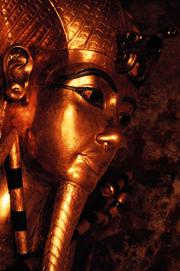Para: AMIGOSEGIPTOLOGIA 1ª) ¿Nació Tutankhamon en Amarna? 2ª) ¿Escondían los antiguos egipcios algún objeto en el interior de las esculturas? Muchas gracias. Un abrazo, Mercedes González Instituto de Estudios Científicos en Momias (IECIM) ------------ http://www.facebook.com/inbox/?tid=419036555075#/pages/Instituto-de-Estudios-Cientificos-en-Momias/140490073140?ref=ts http://www.youtube.com/watch?v=XN-_kiI7aZ4&feature=related http://www.youtube.com/watch?v=dwnNWvtggdA Marcar este mensaje Re: [AE-ES] Ancestry and Pathology in King Tutankhamun's FamilyDe: "JAVIER URIACH TORELLO Añadir remitente a Contactos Para: AMIGOSEGIPTOLOGIA@LISTSERV.REDIRIS.ES El mensaje contiene archivos adjuntos 1 Archivo (129KB) A petición de algún miembro de la lista os adjunto el artículo de Nature, publicado el pasado 16 de febrero y que lleva por título King Tut's death explained? Saludos, Javier Uriach Torelló Marcar este mensaje Re: [AE-ES] Tutankhamon y esculturas egipciasHola Mercedes, con respecto a tu segunda pregunta, las estatuas de Ptah-Sokar-Osiris, o bien las bases sobre las que están fijadas, podían contener en su interior papiros con textos funerarios (aunque en otros casos son papiros con textos de todo tipo, incluso administrativos, colocados quizá por el dueño de la estatua pensando que se trataba de textos funerarios). Desconozco si esto ocurría también en el caso de otro tipo de estatuas, pero si averiguo algo más te lo haré saber. Un saludo, Marina Escolano Para: AMIGOSEGIPTOLOGIA@LISTSERV.REDIRIS.ES no es un articulo, solo una noticia. No está en PDF si es a lo que te refieres. varios compañeros mandaron el enlace, te lo pongo para que lo tengas más a a mano: Espero que te sirva,http://www.nature.com/news/2010/100216/full/news.2010.75.html Hace algunos comentarios muy interesantes y creo que hace mella precisamente en el hecho que a mi me parece fundamental.: los autores han sido muy "entusiastas" a la hora de sacar conclusiones y hacer afirmaciones categóricas. Roser Mercedes González escribió: > Queridos todos ¿Alguien tiene el artículo aparecido en NATURE: King > Tut's death explained? > by Declan Butler. Nature News (16 February 2010) > > Muchas gracias. > > King Tut's death explained?Experts question claims that malaria and osteonecrosis contributed to Pharaoh's decline.  Researchers are sceptical of claims that King Tut died from malaria and a bone disease.Pete Turner/Stone/Getty Images Researchers are sceptical of claims that King Tut died from malaria and a bone disease.Pete Turner/Stone/Getty ImagesA research team says it has solved the mystery surrounding the death of the Egyptian boy-king Tutankhamun, who died in about 1324 B.C. at the age of 19. Some outside experts contacted by Nature, however, are sceptical, saying that the paper's conclusions overstep its data. Genetic fingerprinting done on Tutankhamun, commonly known as King Tut, and ten other mummies also yielded a putative five-generation family tree that includes King Tut's parents. "The paper is of importance since it deals with the most famous of Egyptian mummies. However, most of the results are predictable," says Frank Rühli of the Institute of Anatomy at the University of Zurich in Switzerland and joint head of the Swiss Mummy Project. Imaging results in the report, published today in the Journal of the American Medical Association, indicate that Tutankhamun had osteonecrosis of two metatarsal bones in one foot, according to the authors, and DNA evidence suggests that he was infected with the malaria parasite Plasmodium falciparum1. The team behind the work, led by Zahi Hawass, head of Egypt's Supreme Council of Antiquities in Cairo, thinks that King Tut may have weakened and died from some combination of these conditions — especially considering that he also had a fractured leg2, an injury perhaps sustained as a result of his foot problems. But other experts argue that finding evidence of malaria is unsurprising, given that the parasite was probably common in Egypt at the time. Moreover, in malarious regions people who survive the disease in childhood often acquire partial immunity that protects them against full-blown malaria later in life. The lack of internal organs in mummies makes a definitive diagnosis impossible. "No data are available to assess that malaria was the cause of death," says Giuseppe Novelli, head of the medical genetics lab at Tor Vergata University of Rome. The authors also believe that the malaria finding is "the oldest genetic proof for malaria in precisely dated mummies". Experts say this is no big deal, however, as mummies thought to be from this period and earlier have already been shown to have had P. falciparum malaria3,4. Moreover, changes in the human genome that have been attributed to malaria's influence show that the disease has been around since ancient times5. Differential diagnosisThe damage to King Tut's foot may also be open to alternative explanation, experts say. A diagnosis of necrosis cannot clearly be made from the published images, says Gino Fornaciari, director of palaeopathology at the University of Pisa in Italy, adding that it could be secondary to malaria. Philippe Charlier, a forensic scientist at Raymond Poincaré Hospital in Garches, near Paris, agrees that a misdiagnosis can't be ruled out, saying that the observed necrosis could be the result of "burning or crushing by embalming salts or bitumen". Other foot deformities reported in the paper may well also be due to bandaging and embalming, says Fornaciari. In support of their hypothesis, the authors argue that the presence of canes in King Tut's tomb supports his having had a walking impairment, and that seeds, fruits and leaves found there may have been an "afterlife pharmacy" to help treat King Tut's ailments after death. Fornaciari argues that canes were often used in ancient Egypt and other eastern cultures as a symbol of power. Seeds, fruits and leaves, meanwhile, are found in tombs as 'grave goods' for the afterlife, and are not necessarily medical treatments, says Charlier. Albert Zink Institute for Mummies and the Iceman "We will never be able to prove he died from malaria," admits co-author Albert Zink1, head of the Institute for Mummies and the Iceman at EURAC (European Academy Bozen/Bolzano) in Bolzano, Italy, although the evidence of the malaria parasite raises the possibility. Zink says that he is sure of the osteonecrosis diagnosis, arguing that new bone growth in reaction to the necrosis shows that it occurred before death. Osteonecrosis alone is not fatal but could have been a contributing factor to King Tut's demise, he says. Zink agrees that the alternative explanations for the canes and plant materials are possible, but says that the therapeutic use of canes, and the presence of botanical products typically used to treat fever, provides circumstantial evidence worth reporting. He rejects suggestions that the group overstated its data, but agrees that the paper's assertions on the cause of death are ultimately speculative. The leg fracture, reported last year2 by a group including Rühli and Hawass, could alone account for death, possibly as a result of infection, Rühli says. The genetic fingerprinting of the royal mummies and the resulting family tree is more convincing than the suggested causes of King Tut's death, although most researchers agree that the details provided in the paper do not allow for a full assessment. Eske Willerslev, an expert in ancient DNA at the University of Copenhagen and co-author on a paper published last week in Nature reporting the oldest human genome sequenced so far6, says he's not convinced by the fingerprinting data. Rühli, who last year co-authored a meta-analysis of palaeopathological studies of ancient Egyptian mummies7 and is preparing a book on proposed minimum standards for publication says that despite the criticisms the researchers deserve credit. He points out that evaluating pathologies in ancient mummies is notoriously difficult because of the confounding effects of embalming and time, and because most of the internal organs are missing. He adds that the study itself is scientifically rigorous in a field in which many publications have often been of poor quality. The presentation of the results, however, may be a bit "exaggerated" he concludes.
If you find something abusive or inappropriate or which does not otherwise comply with our Terms or Community Guidelines, please select the relevant 'Report this comment' link. Comments on this thread are vetted after posting.
 
 Disculpen las Molestias 
 Sri Garga-Samhita | Oraciones Selectas al Señor Supremo | Devotees Vaishnavas | Dandavat pranams - All glories to Srila Prabhupada | Hari Katha | Santos Católicos | JUDAISMO | Buddhism | El Mundo del ANTIGUO EGIPTO II | El Antiguo Egipto I | Archivo Cervantes | Sivananda Yoga | Neale Donald Walsch | SWAMIS jueves 11 de marzo de 2010ENCICLOPEDIA - INDICE | DEVOTOS FACEBOOK | EGIPTO - USUARIOS de FLICKR y PICASAWEBOtros Apartados
|
jueves, 25 de febrero de 2010
[AE-ES] Tutankhamon y esculturas egipcias
Suscribirse a:
Enviar comentarios (Atom)
Correo Vaishnava
Archivo del blog
-
▼
2010
(564)
-
▼
febrero
(124)
-
▼
feb 25
(7)
- Re: [AE-ES] Tutankhamon y esculturas egipcias
- Re: [AE-ES] Ancestry and Pathology in King Tutankh...
- Start earning the salary you deserve by obtaining ...
- [AE-ES] Tutankhamon y esculturas egipcias
- [AE-ES] Tutankhamon y esculturas egipcias
- Las Damas de Amarna
- RV: [Amanuense] Noticia: "Tutankamón no era hijo d...
-
▼
feb 25
(7)
-
▼
febrero
(124)
-
►
2008
(83)
- ► septiembre (8)
 Nature.pdf
Nature.pdf


No hay comentarios:
Publicar un comentario